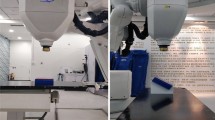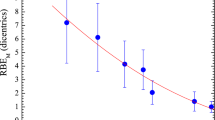Abstract
Peripheral doses out of field could have short and long terms biological effects on patients treated with electron beams. In this study, peripheral dose outside the applicator was measured using the 6, 10 and 18 MeV beams of an Elekta synergy linac. For these beams dose profiles were measured using EBT3 film at various depths within a solid water phantom. Measurements were performed using 6 × 6, 10 × 10, 14 × 14 and 20 × 20 cm2 applicators at gantryangles of 0°, 10° and 20° and depths of 0, 0.5, 1 cm and depth of Dmax (maximum dose) for each energy. The peripheral dose profiles were normalized to the distance of 2 cm from the edge of each field. The largest peak of the peripheral dose was observed for 18 MeV 3 cm from the outer edge of the applicator. Peak dose increased with increasing energy. Peak dose at 18 MeV electron beam was 1.6% at the surface of phantom and at the distance of 2 cm from the outer edge of the applicator when the applicator of 20 × 20 cm2 was used. Peak dose at 6 MeV electron beam was 1.15% at the same distance in the same applicator size. It was found that the peak dose decreased with increasing depth and increased with increase in field size. Also, the peak dose moved towards CAX with increase in gantry angle.In general dose to tissue out of field could be reduced using appropriate shielding for each applicator and beam energy.











Similar content being viewed by others
References
Podgorsak EB (2005) Radiation oncology physics. a handbook for teachers and students Vienna. International Atomic Energy Agency, Vienna
Khan FM (2010) The physics of radiation therapy, 4th edn. Lippincott Williams and Wilkins, Minneapolis
Mayles P, Rosenwald JC (2007) Handbook of radiotherapy physics theory and practice, 1th edn. CRC Press, Boca Raton
Hogstorm KR, Almond PR (2006) Review of electron beam therapy physics. Phys Med Biol 51:455–489
Chow JCL, Newman S (2006) Experimental verification of the application of lateral buildup ratio on the 4-MeV electron beam. J Appl Clin Med Phys 7:35–41
Yeboah C, Karotki A, Hunt D, Holly R (2010) Quantification and reduction of peripheral dose from leakage radiation on Siemens primus accelerators in electron therapy mode. Appl Clin Med Phys 11:154–172
van Battum LJ, van der Zee W, Huizenga H (2003) Scattered radiation from applicators in clinical electron beam. Phys Med Biol 48:2493–2507
Jabbari DK, Roayaei M, Saberi H (2012) Calculation of excess dose to the eye phantom due to a distanced shielding for electron therapy in head and neck cancers. Med Signals Sens 2:144–148
Lonski P, Talor M, Franich R, Harty P, Kron T (2012) Assessment of leakage doses around the treatment heads of different linear accelerators. Radiat Prot Dosim 152:304–312
Mohammad A, Nedaie HA, YarAhmadi M, Banaee N, Naderi M, Tizmaghz Z (2014) Dosimetric evaluation of heterogeneities in small circular fields of 6 MV photon beams with EBT2 and EDR2 films: comparison with monte carlo calculation. J Mod Phys 5:1608–1616
Yarahmadi M, Wegener S, Sauer OA (2017) Energy and field size dependence of a silicon diode designed for small-field dosimetry. Med Phys 44:1958–1964
Yarahmadi M, Nedaie HA, Allahverdi M, Asnaashari KH, Sauer OA (2013) Small photon field dosimetry using EBT2 Gafchromic film and Monte Carlo simulation. Int J Radiat Res 11:215–224
Huizenga H, Storchi PRM (1987) The in-air scattering of clinical electron beams as produced by accelerators with scanning beams and diaphragm collimators. Phys Med Biol 32:1011–1029
Pennington EC, Jani SK, Wen B (1988) Leakage radiation from electron applicator on a medical accelerator. Med Phys 15:763–765
Iktueren B, Bilge H, Karakam S, Atkovar G (2012) The peripheral dose outside the applicator in electron beams of Oncor linear accelerator. J Radiat Prot Dosim 150:192–197
Jabbari N, Hashemi B, Farajollahi AR, Kazemnejad A (2007) Monte Carlo calculation of scattered radiation from applicators in low energy clinical electron beams. Nukleonika 52:97–103
Hall EJ, Giaccia AJ (2012) Radiobiology for the radiologist, 7th edn. Lippincott Williams and Wilkins, Paris
Bagheri G, Sakhaee M, Vahabi-Moghaddam M (2011) Estimation of eye absorbed doses in head & neck radiotherapy practices using thermoluminescent detectors. IJPR 11:215–218
Otake M, Schull WJ (1991) Radiation cataract. J Radiat Res 32:283–293
Wilde G, Sjostrand J (1997) A clinical study of radiation cataract formation in adult life following γ irradiation of the lens in early childhood. Br J Ophthalmol 81:261–266
Dirican B, Oysul K, Beyzadeoglu M, Surenkok S, Pak Y (2004) Experimental lens-paring optimization in therapeutic orbital irradiation with electron beams. Neoplasma 51:390–394
Thorne M (2012) Regulating exposure of the lens of the eye to ionizing radiations. J Radiat Prot 32:147–154
Xu XG, Bednazd B, Paganetti H (2008) A review of dosimetry studies on external-beam radiation treatment with respect to second cancer induction. Phys Med Biol 53:193–241
Ramani R, Russell S, O’Brien P (1997) Clinical dosimetry using MOSFETs. Int J Radiat Oncol Biol Phys 37:959–964
Pradhan AS, Quast U, Sharma PK (1994) A fast and sensitive TLD method for measurement of energy and homogeneity of electron beams using transmitted radiation through lead. Phys Med Biol 39(9):1367
Acknowledgements
The authors gratefully acknowledge the Research Council of Kermanshah University of Medical Sciences (Grant Number: 94162) for the financial support.
Author information
Authors and Affiliations
Corresponding authors
Ethics declarations
Conflict of interest
Abbas Haghparast, Fatemeh Amiri, Mehran Yarahmadi, and Mohammad Rezaei declares that they have no conflict of interest.
Ethical approval
This article does not contain any studies with human participants or animals performed by any of the authors.
Rights and permissions
About this article
Cite this article
Haghparast, A., Amiri, F., Yarahmadi, M. et al. The peripheral dose outside the applicator in electron beams of an Elekta linear accelerator. Australas Phys Eng Sci Med 41, 647–655 (2018). https://doi.org/10.1007/s13246-018-0660-9
Received:
Accepted:
Published:
Issue Date:
DOI: https://doi.org/10.1007/s13246-018-0660-9




